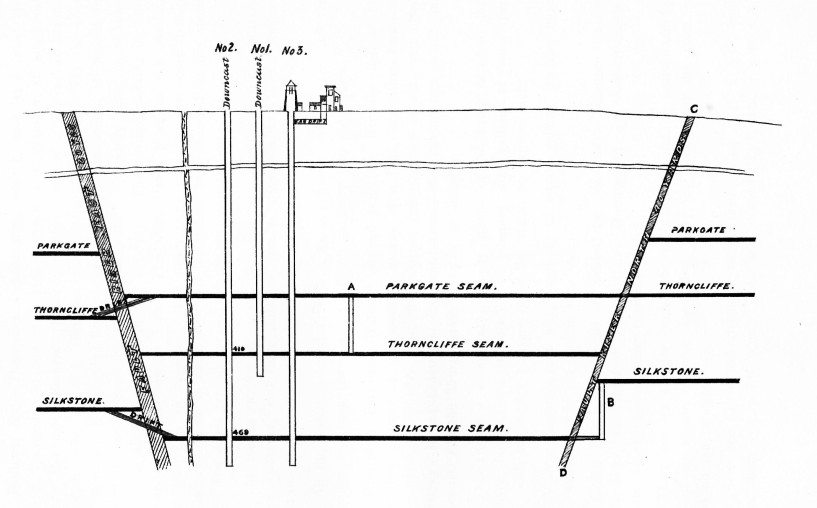Barrow Colliery, near Worsbrough takes its name from the owning company, the Barrow Haematite Steel Company Limited, first established in 1864 which had iron ore mines in the Furness area in Lancashire and Cumberland.


The board of the Barrow Hematite Steel Co.

View of the Barrow works

Blast furnaces at Barrow

Chairman of the Barrow Hematite Steel Co., The Duke of Devonshire
The colliery consisted of three pits, the first sod for which was cut on the 4th of June 1873.
No. 1, 15ft diameter, a downcast shaft , 410 yards deep to the Thorncliffe seam, it was used to wind coal from both the Parkgate and Thorncliffe seams. 42 yards of the shaft were tubbed, that is lined with metal sections fastened together to hold back the sides and water.
No.2, also 15ft diameter and downcast, 469 yards deep to the Silkstone seam. 42 yards was tubbed.
No.3, upcast shaft, 17ft diameter, sunk to the Silkstone. 81 yards of the shaft depth was tubbed.

Sketch plan of Barrow Colliery Seams, from, British Society of Mining Students, Vol.XV, No.6, 1893, pp.160-168
Winding engines at nos 1 & 2 pits were similar, being horizontal engines built by Daglish & Co., of St Helen’s, with 36 in diameter cylinders with 6ft stroke, 80 lbs per square inch powering steel winding ropes 1 and a half inch diameter over pullies 18ft diameter from drums 20ft diameter and 7ft wide. The cages had three decks, each holding 2 x 10cwt, making a load of 3 tons for each wind.
At No.3 shaft the winding engine had 26 in cylinders, 5 feet stroke, used for transporting the workmen.
Coke Ovens
There were:
- 35 Simon Carves ovens, 32 feet 9 and a half inches long, 20 feet wide, 8 feet 2 and a half inches high with horizontal flues.
- 10 Poetter ovens, 33 feet x 20 inches x 8 feet 2 inches with vertical flues.
From these 45 ovens, the bye-products produced inculded sulphate of Ammonia, Benzol, and Tar.
Banking plant
The coal raised was tipped on shaking screen and delivered to picking belts. The small dross was conveyed into a hopper by creepers.
In 1889 the extensive coal screening and Robinson conical washing plant were described in the Report of the Mining Institute of Scotland’s Coal-Cleaning Committee when the output was 1,200-1,500 tons per day.

Side view of dross elevator, disintegrator, washer and creepers at Barrow Colliery (Trans. M.Inst.Scot., Vol.XI, plate XIII)
The surface arrangements are very extensive and complete, and are carried out with great skill. The coal worked is the well-known Silkstone seam. The produce is graded at the pithead into six kinds, the relative values being approximately as follows:-
- Lumps 100
- Gas coal 85
- Steam coal 85
- Nuts 78
- Peas 60 } both taken to
- Smudge 60 } boilers or washer as required
Dry Cleaning
The coal is filled underground with the ordinary close shovel and sent to bank as tripping, and there prepared for market. The hutches are made of wood and have close ends, the boxes being about 4ft. long, 3ft. wide, and 2ft. deep; capacity, 9 to 10 cwts; wheels, 8ins. diameter; with flanges to run on edge rails laid to a gauge of 24 inches.
[…]
Wet Cleaning
The washing machines are placed at a distance from the screens, and the dross is carried from the one to the other in railway waggons. These discharge it into a hopper, from which it is elevated and passed through a disintegrator. reduce it to practically uniform size. Thereafter it is delivered into the conical hopper of a Robinson washer…
Transactions. Mining Institute of Scotland, Vol. XI, 1889-1890, pp.158-163
Later dross was taken by means of an aerial ropeway in skips of 10cwts, over to 2 hoppers of 100 tons capacity.
Ventilating plant
There was a 26 feet diameter Walker indestructible fan, 9 feet wide, producing 190,000 cubic feet of air per minute, drawing 3 and a half inches of water gauge. It was driven by a pair of compound engines with 23 inch high pressure cylinders, 38 inch low pressure cylinders, steam pressure at 80lbs per square inch. There was also a 46ft Guibal fan, 15ft wide kept as a spare in case of breakdown.
Electrical plant
Electricity was used for lighting and for the compressing plant at the coke ovens. Two dynamos supplied power to 1,100 and 450 lights.
The Barrow collieries were a large employer in the area, and they had specific work prices agreed with the miners union, as below.

Yorkshire Miners’ Association, Price list for Barrow Collieries, Silkstone seam, October 1886 (Private Collection)

Price List August 1939 (Private Collection)

1907 Barrow Colliery Disaster Postcard (by Warner Gothard [1866-1940] of Eldon St, Barnsley, courtesy private collection)
Sources
Atkinson, Alfred Ashley [1858-1939], ‘Barrow Colliery’, Journal of the British Society of Mining Students, Vol.XV, No.6, August 1893, pp.160-168
Harris, Henry Charles [1877-1944], ‘Scotch mining students visit Yorkshire coalfield’, Mining Engineering: an illustrated journal of coal mining and engineering for colliery managers and mining engineers, Vol.X, No. 147, October 1906, pp.242-247, and No.148, November 1906, pp.263-266